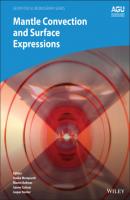Mantle Convection and Surface Expressions. Группа авторов
Чтение книги онлайн.

Читать онлайн книгу Mantle Convection and Surface Expressions - Группа авторов страница 48
Название: Mantle Convection and Surface Expressions
Автор: Группа авторов
Издательство: John Wiley & Sons Limited
Жанр: Физика
isbn: 9781119528593
isbn:
For a truncation of the Helmholtz free energy after the fourth‐order term in finite strain, the components of the isentropic elastic stiffness tensor are given by (Davies, 1974; Stixrude & Lithgow‐Bertelloni, 2005):
where δijkl = −δijδkl −δilδjk −δjlδik. The parameters of the cold part (lines 1–5) of this expression are the components of the isothermal elastic stiffness tensor cijkl0 at the reference state and their first and second pressure derivatives
In an analogous way, the first and second pressure derivatives of the components of the elastic stiffness tensor combine to the first and second pressure derivatives of the bulk modulus
The thermal contribution (lines 6–7) includes the changes in internal energy ΔTHU and in the product of isochoric heat capacity CV and temperature T, ΔTH(CVT ), that result from heating the mineral at constant volume V from the reference temperature T0 to the temperature T. The internal energy U is computed from a Debye model (Ita & Stixrude, 1992) based on an expansion of the Debye temperature θ in finite strain (Stixrude & Lithgow‐Bertelloni, 2005). The Grüneisen tensor is then defined as:
and the strain derivative of the Grüneisen tensor as:
The Grüneisen tensor and the tensor ηijkl are functions of finite strain themselves that are parameterized using their values at ambient conditions, i.e., γij0 and ηijkl0 (Stixrude & Lithgow‐Bertelloni, 2005).
Seismic waves travel with wavelengths on the order of kilometers that by far exceed the grain sizes of mantle rocks. Seismic waves thus probe the elastic response of a collection or an aggregate of mineral grains. In the simplest case of a monomineralic aggregate, all grains are crystals of the same mineral. The crystals can be randomly oriented or aligned to form a crystallographic preferred orientation (CPO). CPO can result from deformation or from crystallization of mineral grains under the action of an anisotropic external field (Karato, 2008). In general, crystals are elastically anisotropic, and any preferred orientation of crystals will partly transfer the elastic anisotropy of individual crystals to the aggregate (Mainprice, 2015; Mainprice et al., 2000).
When combining the elastic properties of individual crystals to those of the aggregate, we further have to take into account that stresses and strains may not be distributed homogeneously throughout the aggregate as some crystals may behave stiffer and deform less than others. The effective stiffness of a crystal depends on the orientation of the crystal with respect to the imposed stress and strain fields. Crystals may also be clamped between neighboring grains and be forced into a strain state that may not correspond to a state of unconstrained mechanical equilibrium with the imposed external stress field. Approximations and bounds to the complex elastic behavior of crystalline aggregates have been reviewed by Watt et al. (1976). Here, I adopt the simplest bounding scheme based on the Voigt and Reuss bounds (Reuss, 1929; Voigt, 1928; Watt et al., 1976) and assume a random orientation of crystals.
The Voigt bound is based on the assumption that the strain is homogeneous throughout the aggregate (Reuss, 1929; Watt et al., 1976). Regardless of its orientation, each crystal in the aggregate is deformed according to the external strain field imposed, for example, by a seismic wave. Because the resulting stresses are calculated from the strains using the elastic stiffnesses, we need to average the components of the elastic stiffness tensor cijkl over all orientations. For a monomineralic aggregate, this leads to the following expressions for the isotropic bulk modulus K and the isotropic shear modulus G (Hill, 1952; Watt et al., 1976):
The Reuss bound assumes that the imposed external stress field is homogeneous throughout the aggregate (Reuss, 1929; Watt et al., 1976). In this case, the strains are calculated from the stresses using the components of the elastic compliance tensor sijkl. The isotropic bulk and shear moduli of a monomineralic aggregate of randomly oriented crystals are then (Hill, 1952; Watt et al., 1976):